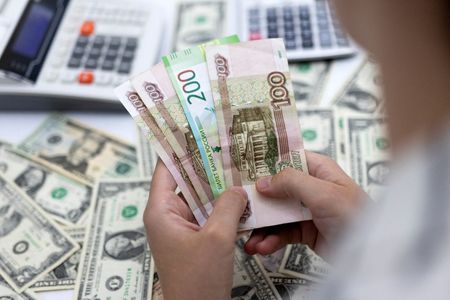
(Reuters) -The rouble soared on Friday to its strongest level against the dollar since late May, close to multi-year peaks, after Russia’s central bank cut its key interest rate by 150 basis points to its pre-crisis level of 9.5% and Moscow eased some capital controls.
The central bank, exceeding average expectations of a 100-basis-point move in a Reuters poll earlier this week, said it would explore the scope for more cuts as inflation slows from near 20-year highs and economic contraction looms.
Lower rates should put some downward pressure on the rouble and support prices of OFZ treasury bonds, but the currency is still buoyed by capital controls that were imposed in the aftermath of Moscow’s decision to send tens of thousands of troops into Ukraine on Feb. 24.
By 1425 GMT, the rouble was 4% firmer at 56.98 to the dollar, its strongest level since May 25.
It gained 5.3% to trade at 59.92 to the euro, also its strongest in more than two weeks.
On the local debt market, yields on 10-year OFZ treasury bonds fell to 8.84%, their lowest since Jan. 13. Bond yields move inversely to prices.
Governor Elvira Nabiullina said the bank was adhering to its floating exchange rate policy in spite of monetary restrictions.
She said the rouble price affected different economic actors in different ways: “Exporters are often interested in weakening the exchange rate, and importers in strengthening it.”
Vladislav Danilov, senior analyst at First AM, said the balance of exports and imports remained the main driver for the rouble rate.
EASING CAPITAL CONTROLS
Alfa Capital analyst Alexander Dzhioev said the rate cut was unlikely to affect the rouble substantially, in view of the curbs on capital flows.
“Nevertheless, it is worth noting that, in combination with other factors, for example, abolishing mandatory foreign currency earnings sales by exporting companies, the currency could stop strengthening,” he said.
The finance ministry said export-focused companies no longer had to convert their forex earnings, with immediate effect.
Analysts have credited the exchange requirement with helping to stop a dramatic slide in the value of the rouble after Western governments froze around $300 billion of the central bank’s currency reserves immediately after the start of Russia’s military campaign.
Until May, Russian companies had been required to sell 80% of their hard currency earnings, and then 50%.
FOREIGN CURRENCY APPEAL WANES
Some major Russian banks plan to charge fees on retail accounts in dollars and euros after authorities floated the idea of negative interest rates on the foreign currency deposits of corporate depositors, reducing their appeal and buttressing the rouble.
“The rouble is likely to see support from the waning appeal of savings in the currencies of ‘unfriendly’ countries,” said SberCIB Investment Research.
The central bank said it would study the legality of banks’ plans, but Nabiullina said they posed no threat to financial stability.
On stock markets, the dollar-denominated RTS index was up 4% at 1,261.3 points. The rouble-based MOEX Russian index was down 0.6% at 2,281.2 points.
(Reporting by Reuters; Editing by Kevin Liffey)

